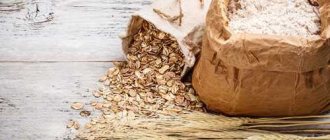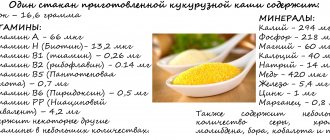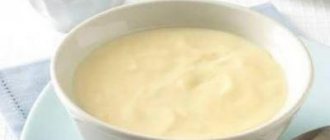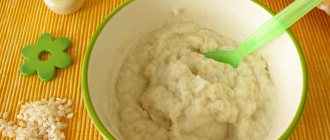Specialized departments of retail outlets provide a huge selection of baby cereals, including milk mixtures with the addition of buckwheat flour and dairy-free ones with fruit and vegetable additives. In addition to the well-known mixtures, you can also find buckwheat porridge on sale for first feeding, intended exclusively for babies. However, in reality, such porridge does not differ in nutritional and taste qualities from ordinary premium quality kernels, and is simply another marketing ploy to increase sales volumes and make large profits on the same product. The strategy is designed for parents who want the best for their children, and by the way, it successfully justifies itself.
Choosing porridge for babies
So which is the best porridge for a child? Of course, you should choose only from samples of the highest grades, which necessarily contain the name of the kernel in their labeling. This cereal consists of whole grains and contains the maximum amount of fiber, trace elements and minerals.
The next thing you should pay attention to is the color of the cereal. Green and brown, and the point here is not the variety, but the degree of preparation. Dark grains have undergone special heat treatment, and it would seem that most of the beneficial substances in them are destroyed under the influence of high temperatures and they are less useful. However, the glycemic index of fried cereal is slightly higher than 54, while green cereal is only 40, which means it is much easier to digest. Therefore, it is better to choose it for complementary feeding.
Harm and contraindications
Buckwheat porridge, like any new product, can cause problems with stool (constipation, diarrhea, flatulence) and the digestive system. In the process of complementary feeding, allergic manifestations are possible in the form of rashes, itching, redness and peeling of the skin.
Buckwheat has virtually no contraindications, with the exception of individual intolerance to the product and acute gastrointestinal diseases.
Buckwheat is a unique grain; it is very useful for both adults and small children under one year old. Its benefits have been known for a long time. Even in the old days, when people had not yet heard about various scientific studies, buckwheat was already one of the main products. It adds strength, the child grows faster, becomes healthy, strong and smart.
Compound
The composition of buckwheat, rich and saturated with useful substances, is combined with its high nutritional value. The child is well saturated with buckwheat porridge.
At the same time, the calorie content of the cereal is low - one hundred grams of the product contains only 110 calories, if you do not consume it with milk.
The unique nutritional value is primarily due to the rich content of easily digestible fiber, slowly processed carbohydrates and complete protein.
They are indispensable for maintaining the child’s nervous system in order.
Buckwheat is very rich in iron. This is the prevention of anemia.
- Calcium in cereals strengthens children's bones and is beneficial when children up to one year old and after are teething.
- Potassium helps the heart beat more smoothly and become stronger. Buckwheat also contains many minerals in smaller quantities, such as manganese, cobalt, zinc, copper and sodium.
- Buckwheat contains especially healthy carbohydrates that are slowly absorbed, so they keep you feeling full for a long time and give you strength for a long time. This factor makes buckwheat recipes indispensable in children's kitchens.
We suggest you read: Which fish is best to cook in batter?
Buckwheat is useful due to the content of complete, healthy protein - the child grows quickly and becomes stronger.
About ten percent of buckwheat contains dietary fiber, which allows us to consider this cereal as a dietary dish. Fiber improves intestinal motility, which facilitates the functioning of the baby’s digestive system.
So, eating buckwheat porridge solves the problem - but at first it is undesirable for this reason to give porridge with milk to a child under one year old.
If you overfeed a child with buckwheat porridge, this can lead to flatulence. This is also why there is bloating and mucous discharge.
Buckwheat must be stored correctly; this grain very quickly “takes over” all the odors heard nearby and becomes no longer so useful.
No particular harm was observed with buckwheat. Pediatricians only warn against overfeeding children when it comes to this product. And it is important not to give buckwheat porridge with milk to a child until 8-9 months old - the body must first get used to the new product.
Benefit
- Buckwheat strengthens children's immunity. It contains a special flavonoid called “rutin”, which can enhance the positive effects of vitamin C in the body.
- Buckwheat has a positive effect on the growth of the muscular system. The child needs to grow, and he does it quite quickly, including due to the fact that his menu contains buckwheat recipes.
- Positively affects digestion. Fibers can push food along the tract, thereby making life easier for a baby up to a year old.
- Buckwheat porridge is useful for preventing anemia. A child with anemia becomes apathetic and lethargic, unable to actively develop, play and explore the world. Buckwheat copes with this problem by delivering a sufficient amount of complete iron to the child’s body.
- The product is hypoallergenic. In extremely rare cases, a child may have a congenital intolerance to buckwheat. As a rule, this is accompanied by intolerance to other foods. There have not yet been any specific cases of buckwheat allergy in children.
- Buckwheat does not contain gluten, since it is not a cereal, but a herbaceous plant. The presence of gluten often causes children to become intolerant to many cereal porridges. Therefore, buckwheat porridge becomes one of the first dishes for complementary feeding of a baby up to one year old.
When to give
Until the baby reaches six months, it is quite possible to live exclusively on mother’s milk. In this case, he receives all the necessary substances. In addition, when consuming breast milk, children, as a rule, have no digestive problems and develop correctly.
Buckwheat recipes may well become your baby’s first complementary foods. Buckwheat can also be introduced as a second complementary food after vegetables. The second is even preferable, since introducing vegetables to a child under one year of age will be better from a nutritional point of view. If the baby is artificial, then the first liquid buckwheat porridge can be given to him as early as 4-5 months.
The kernel is preferable, since in whole grains, again, all the beneficial substances are better preserved. Although the flakes and flour are extremely ground and are absorbed very quickly, but, alas, after strong processing such buckwheat is no longer useful. Plus, recipes made with whole grains taste better.
Choose light cereals; in this case, the roasting of the cereal is minimal, which means that it retains all its beneficial properties as much as possible.
It is better to start feeding a baby up to one year old with buckwheat porridge without milk. In this case, the child is guaranteed not to have constipation when switching to a new type of food. You can also use ready-made factory-produced cereals. In most cases, they already contain powder from fruits and vegetables, and are enriched with vitamins and minerals.
How to cook
Buckwheat porridge recipes for first complementary foods imply the absence of milk, sugar and salt. At 8 months you can already cook it with milk, add cream or butter.
Before giving the porridge to the baby, you need to grind it. Ready-made cereals are usually liquid, so the child can feed them from a bottle.
Usually, when switching to eating porridge, the baby, having eaten, begins to sleep peacefully at night, which brings great relief to the parents.
- Buckwheat porridge recipe for infants
- Sort through the cereal, removing all specks and spoiled grains.
- You need to grind the buckwheat in a coffee grinder.
- Pour the resulting mixture with water in proportion to one tbsp. spoon - half a glass of water.
- Bring to a boil and simmer for 15 minutes.
- Cool. If the child's age allows it, add milk.
- That's it, the porridge is ready, you can feed the baby.
- Recipe for children over one year old
- Sort through the cereal.
- There is no need to grind anything here anymore. Simply add water to the cereal and bring to a boil.
- After the porridge has boiled, drain the first water - this will remove the bitter taste from the finished dish.
- Pour water over the cereal again and cook for half an hour.
- Add sugar to the cooking process.
- Add a little butter to the prepared hot porridge and cool. You can also top it with milk.
But the greatest benefit is from eating buckwheat porridge without milk. In this form, it is especially easily absorbed by the body. In addition, in this case the child does not suffer from constipation. In any case, buckwheat porridge - with or without milk - is an indispensable dish for a child. It should definitely be included in the baby’s diet, but in moderation.
Preparing buckwheat for cooking
Although the highest grades of buckwheat practically do not contain foreign impurities, before preparing buckwheat porridge it should be sorted out. Remove specks and black fragments, do not be alarmed, these are not spoiled grains, but simply not peeled from the shell, and such porridge will not cause any harm to the baby’s health.
Then the cereal is washed well, removing dust and buckwheat plaque. It is better to do this not under running water, but by collecting it in a container. Thus, the debris will float to the surface and can be easily drained with the liquid several times. After this, buckwheat is considered ready for cooking.
Basic rules for preparing porridge for a baby
Warning. Fried buckwheat has a bitter taste, and if it is practically unnoticeable to an adult, a baby is unlikely to appreciate it. Therefore, when cooking, you should use the 2-water rule. What does it mean? The cereal is poured into cold water and placed on the stove. After boiling, the liquid is drained, and the porridge is transferred to a pan with new water and cooked until tender.
Naturally, baby buckwheat porridge should be made liquid, because at the age of 6 months there are no teeth for grinding food. But whether to feed a child with a spoon or a bottle depends on the personal preferences of the parents and the individual characteristics of the baby. If by this period the child knows how to eat from a spoon, swallows well, and does not push food out with his tongue, of course, preference should be given to this method of feeding. If the child is not ready for such a meal, it is necessary to dilute it to the consistency of drinking and feed it from a bottle.
Of course, there can be no talk of any salt in buckwheat porridge for complementary feeding. Up to a year, you can avoid salting any food at all, because this is a serious burden on the baby’s fragile kidneys. Even if it doesn’t seem tasty to you, it’s just a matter of the habit of your taste buds, and for a baby this doesn’t really matter, all food is equally unfamiliar to him.
The same goes for sugar. It is necessary to push back as far as possible the moment the child becomes acquainted with sweets. No matter how tasty it may seem to you, there is no benefit.
Recipes for buckwheat dairy-free porridge for first feeding
Being a source of protein, it also contains iron, which helps maintain hemoglobin levels in the blood, calcium, essential for the growth of bones and teeth, plus it is rich in iodine, phosphorus, manganese, B vitamins and PP.
In addition, buckwheat is easily absorbed by the child’s body and its consumption does not lead to constipation.
Buckwheat porridge is not only satisfying, but also contains a lot of useful vitamins and microelements
All about the benefits of buckwheat
It is difficult to evaluate all the beneficial qualities that buckwheat has. In addition to the fact that it contains a large number of vitamins and mineral elements, buckwheat supplies the child’s body with all the necessary substances for its full functioning. However, a balanced composition is not its only advantage.
The advantages of the composition of such porridge include:
- Content of complex carbohydrates. Carbohydrates of this type do not increase blood sugar levels, which is typical for simple or so-called fast carbohydrates. Thanks to them, the body remains feeling full for a long time, since their breakdown is accompanied by the release of a large amount of energy.
- The presence of very valuable proteins of plant origin. Their value lies in their easy digestibility and stimulation of the dynamic development of muscle mass. In addition, the proteins contained in buckwheat are rich in amino acids, the complex combination of which is recognized by experts as the most balanced among food products.
- Availability of fiber. Normal digestion depends on these dietary fibers, as they enhance intestinal motility. The amount of dietary fiber in buckwheat is 5-10%, which is three times the amount in rice.
- Gluten free. Buckwheat belongs to the family of herbaceous, rather than cereal, plants, which include wheat, oats, barley and rye. It is the latter that contains this vegetable protein. As a result, buckwheat will not cause allergies or digestive disorders in children intolerant to gluten, which means it is an ideal first complementary food.
We invite you to familiarize yourself with the Recipe for secondary wine from grape pulp. How long to keep the drink, how to strain and store?

Buckwheat does not contain gluten (gluten), so it is suitable for children with gluten intolerance
What benefits make buckwheat stand out from other cereals? This:
- Strengthening the immune system. Buckwheat helps support the immune system due to the content of a substance such as rutin. It, in turn, enhances the effect of vitamin C, and therefore buckwheat porridge is perfect for preventing acute respiratory infections and colds in children.
- Helps in muscle development. The increase in muscle mass occurs due to the large amount of proteins and complex carbohydrates in the porridge.
- Normalization of the gastrointestinal tract, which is ensured by fiber, which promotes natural metabolism.
- Prevention of anemia. Here the matter could not have happened without iron, which it is so rich in. Iron deficiency in the body is dangerous because the bone marrow produces an insufficient amount of hemoglobin. It is a protein found in blood cells that carries oxygen through the bloodstream. This is fraught with weakened immunity, low activity and a constant feeling of fatigue.
- Strengthening the heart muscle and blood vessels. Potassium in large quantities has a positive effect on the functioning of the cardiovascular system.
- Hypoallergenic. An allergic reaction to buckwheat is much less common than to other cereals. An allergy in an infant can only be caused by personal intolerance to the product, an explanation for which does not yet exist.
The period for introducing buckwheat into complementary foods initially depends on the type of feeding. In the case when the baby eats exclusively from the mother's breast, during the first 6 months breast milk should be enough for him. Upon reaching the age of six months, you can already feed your baby.
The most useful for the body are kernels - whole grains, peeled from the surface shell. You can also prepare porridge from buckwheat flour or Smolensk buckwheat (peeled and finely ground grains). However, both products are inferior in nutritional and beneficial properties to the kernel.
How to cook buckwheat for babies in water:
- Sort the kernels, rinse until clear water, and dry.
- Transfer the grains to a blender or coffee grinder and grind to flour.
- 1 tsp. buckwheat flour pour 100 ml of purified water, after boiling, cook for 15-20 minutes. Cool to room temperature.
For a one-year-old child and older children, water is replaced with low-fat milk. Pediatricians do not recommend eating milk porridge for babies under one year old, as they negatively affect the mucous membrane of the digestive tract and increase the risk of gastrointestinal diseases.
How to grind
Grind buckwheat (kernel) or ready-made porridge.
In the first case, the algorithm of actions is as follows:
- Sort the grains, clean them from foreign impurities.
- Rinse well, strain off excess water through a colander, and dry the cereal.
- Next, using a blender or coffee grinder, grind the grains to flour.
How to cook buckwheat for babies:
- Dry quality cereal in the oven until it turns golden brown.
- Pour the grains with water in proportions 1:2, boil until tender for 15-20 minutes, cool.
- Place the warm porridge in a blender and grind well. Add water, adapted formula or breast milk to the desired consistency.
It is convenient to use a sieve as a kitchen utensil. To do this, the prepared buckwheat porridge without water is ground through it and diluted with water.
Additives to porridge
If the child refuses to eat unleavened buckwheat porridge, add breast milk or an adapted formula to it. A baby 8 months and older will have a more varied diet. Its menu includes vegetables, fruits, berries, fish, meat, dairy products, cottage cheese, herbs, and vegetable oil. All of the above products go well with buckwheat.
Children are least likely to be allergic to vegetables. Experts recommend initially combining buckwheat with zucchini, carrots, cauliflower and broccoli, pumpkin, or with mildly and moderately allergenic vegetables (banana, pear, green apple, peach). Next in age are fermented milk products (natural yogurt, kefir), cottage cheese, lean meats (beef, turkey, rabbit).
When creating a diet, focus on your baby’s taste preferences and eating habits. What is healthy and tasty for one child will be unacceptable for another.
Calculating the serving rate
The required number of calories for a child is calculated using various methods, but on average this figure is close to that indicated in the table.
| Baby age months | Number of calories per 1 kg of weight per day |
| Until 3 | 125 |
| Z - 6 | 115 — 120 |
| 6 — 9 | 110 — 115 |
| 9 -12 | 110 — 105 |
Typically, children under 5 months eat 6-7 times a day; after the introduction of complementary foods, the number of meals is reduced to 5. Using the calorie table and the required daily intake, it is easy to calculate the portion suitable individually for each child.
Important thought. Please note that the packaging indicates the number of calories per 100 g of dry product. If you take 50 g of cereal for cooking, this is 170 kcal. And this value will remain constant, no matter how much water you add during cooking and dilution.
But if you prefer to dilute with broth or milk, then accordingly add the energy value of these products.
There is no need to try to feed your baby a whole portion from the first day; this is very dangerous for the child’s body. You need to start with half a teaspoon, gradually increasing the daily amount. After 2 weeks, the volume will reach 150 g and will be sufficient for full feeding.
Cooking method
Let's look at several options for preparing buckwheat porridge for babies.
You can cook the porridge in a saucepan on the stove, or in a double boiler. A slow cooker is not very suitable due to the small volumes of portions, because the prepared product should be consumed immediately, without leaving it for next time.
Recipe No. 1
- Buckwheat is poured into cold water and brought to a boil.
- Place the grains in a colander. Pour in a new volume of water in a ratio of 1 to 5 and cook over low heat for 15 – 20 minutes.
- The boiled porridge is ground in a blender and diluted with liquid to the desired consistency
Recipe No. 2
- Buckwheat is ground in a coffee grinder to the consistency of flour.
- Pour into boiling water in a thin stream, stirring constantly to prevent the formation of clots and lumps.
- Cook over low heat for 15 minutes.
But it may happen that the child simply refuses buckwheat, in which case buckwheat porridge with milk can save the situation. It is not at all necessary to cook cereal with milk; you can simply dilute the finished porridge with breast milk or baby formula that is familiar to a baby.
Buckwheat porridge for the first feeding: how to prepare a baby?
Your little one is growing every day. And so, when mother’s milk or baby formula no longer satisfies the baby’s hunger, the baby’s parents think about complementary feeding. The ideal dish for butuz would be low-allergenic porridge made from kernels. So, buckwheat porridge for the first feeding - how to prepare cereal for a child?
Pediatricians advise introducing complementary foods into a child’s diet between 4 and 6 months. If the baby was bottle-fed, he can try his first porridge at 4 months. For infants, introduction to new foods can be delayed. It is believed that upon reaching six months of age, a child stops eating his mother’s milk or formula. What cereals are suitable for complementary feeding?
Rice is suitable for a premature baby or a baby who is not gaining weight well. This cereal is rich in dietary fiber.
- However, parents are afraid to introduce their child to such healthy rice porridge, since it is believed that eating this cereal causes constipation.
- We hasten to reassure mothers: only a dish of broken rice can fix the baby’s stool. If you use rice flour for cooking, there will be no side effects.
- Oatmeal is rich in proteins and minerals, but it can only be introduced into a child’s diet when he or she is one year old. There is no need to rush into feeding corn porridge. Although cereal is a source of fiber and microelements necessary for a growing body, it is not suitable for the digestive system of a baby. Corn porridge is introduced into complementary foods after the baby is introduced to other cereals. So what remains?
- Modern pediatricians say that boiled buckwheat is the ideal option for early complementary feeding. This dish is a storehouse of vitamins and beneficial microelements that a growing body needs. In addition, the kernel rarely causes allergies.
However, buckwheat, like any other product, should be administered with caution. It’s better not to rush into gastronomic delights, but to use a proven recipe. After all, a dish for a baby should be as simple as possible. Buckwheat porridge - the baby's first complementary food - should be prepared without adding salt, sugar or butter.
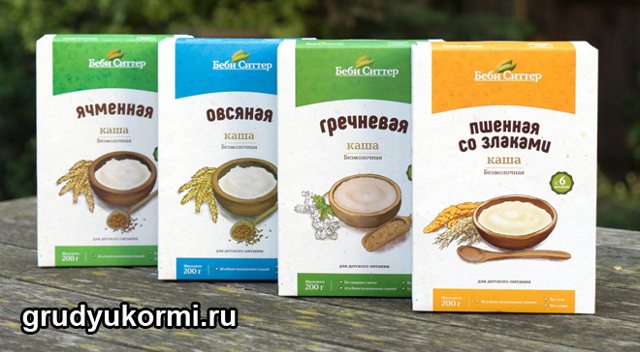
How to introduce complementary foods? After introducing the baby to buckwheat, a new product should not be given to the baby earlier than 2-3 weeks. During this time, it is worth monitoring the body’s reaction and keeping a food diary for convenience.
Yadritsa is the No. 1 cereal not only for the baby, but also for his parents. It is rich in the most useful microelements. Let's look at the positive aspects of buckwheat.
| complex carbohydrates | these elements are an invaluable source of energy for the growth of the little fidget |
| vegetable protein | necessary for the active formation and development of the muscular skeleton |
| increased fiber content | strengthens the functioning of the gastrointestinal tract |
| B vitamins | necessary for the proper functioning of a vital organ - the heart. Strengthen immunity |
In addition, buckwheat extremely rarely causes rashes and other manifestations of allergies or dermatitis, since it is hypoallergenic.
However, the kernel can also lead to negative reactions in the body. So, if a porridge recipe contains additional ingredients that are not suitable for the baby’s age, the child’s gastrointestinal tract may “rebel.” In addition, from excessive consumption of buckwheat, the baby may experience bloating, colic, constipation or, conversely, loose stools. Therefore, it is necessary to observe the measure.
Children with neurological problems require special attention. Buckwheat dishes can increase body tone. In addition, mucus may appear in the stool.
However, to introduce kernels into complementary foods, you should adhere to the following rules:
- For your first porridge, choose only whole grain cereals or a ready-made mixture from a trusted company.
- The recipe should not contain cow's or goat's milk, butter, salt or sugar. Naturally, dried fruits and other additives are contraindicated for a baby before reaching 6 months of age.
- Buckwheat should be cooked immediately before feeding. It is extremely undesirable to offer cereals cooked the day before to your baby.
- The first portion of porridge should not exceed a teaspoon. On the second day, the baby is offered about 20 grams of porridge. Within two weeks, the amount of product in the baby’s diet is increased to 150 grams.
- You should treat your child to a new dish only in the morning to avoid negative reactions from the body during night sleep.
- First - complementary feeding, then - breastfeeding or a bottle of formula.
- A food diary will help mom well in complementary feeding. Monitor whether your child experiences constipation, bloating, or increased gas formation due to this or that product.
To ensure that your baby likes buckwheat, the cooked cereal can be diluted with breast milk or an adapted infant formula.
So, how to prepare buckwheat porridge for the first feeding of a baby? Let's look at popular recipes below.
How to cook porridge for a baby? It is important to adhere to some rules, namely: choose a core from a trusted manufacturer and sort the grain before cooking. Prepare food for your child only on the stove. The use of a microwave oven is not allowed, as microwave radiation negatively affects food. Let's look at the most popular recipe.
- Check the cereal for low-quality grains.
- The kernel must be washed under running water several times, and then dried in the oven at low temperature.
- To grind the cereal, use a coffee grinder (just be sure to clean it well before use) or a food processor or blender. Grind the core.
- To prepare, take one teaspoon of buckwheat and pour 100 ml of purified water into it. It is best to use bottled water or filtered water for these purposes.
- For cooking, you need to use a saucepan with thick walls: bring the porridge to a boil and simmer over low heat for another quarter of an hour.
- Afterwards, cool to a comfortable temperature and dilute the dish with breast milk or formula.
We invite you to familiarize yourself with Plums in syrup for the winter, recipe without sterilization
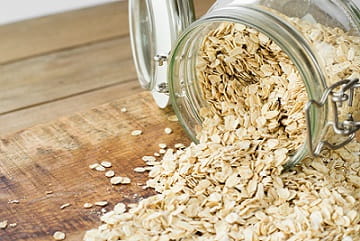
It is worth noting that in some regions, pediatricians advise young mothers to start complementary feeding with a spoon. Doctors say: this way of getting to know food will have the most positive effect in the future - the baby will quickly master the chewing reflex.
How to cook buckwheat porridge for introduction into complementary foods from a spoon? For this recipe, mom will have to spend a little more time in the kitchen, but there will be more benefits from such a dish. Buckwheat will retain almost all its beneficial properties:
- Sort out the cereal (2 tablespoons dry) and rinse the grains with running water.
- Turn on the oven and dry the clean kernel in it.
- While the buckwheat is cooling, turn on the stove and bring a liter of water to a boil.
- Pour the grains into the water and bring everything to a boil again.
- Then reduce the heat to low and cook the porridge for about an hour, covering the pan with a lid.
- If the cereal is thoroughly boiled, place it in a sieve and use a masher to puree the resulting dish twice.
- Add a couple of tablespoons of boiled water to the porridge until you obtain a homogeneous consistency.
If the baby is already six months old, then fruits can be introduced into his diet, for example, banana and dried fruits (pre-boiled) - dried apricots and prunes. These ingredients can be added to baby's porridge. How to cook buckwheat for porridge with topping? Choose any of the recipes you like, but before serving the dish, add pureed fruit or dried fruit to it.
Maybe a semi-finished product?
Of course, the best solution for feeding a baby is cereal prepared by the mother herself. However, the rhythm of life makes us run faster and faster, and some parents, in order to save time, prefer to buy ready-made cereals.
In addition, diluting such a mixture in the amount required for the first feeding (literally a couple of teaspoons) is easier than boiling a regular egg and measuring out several spoons. Do not rule out the possibility that the child will not like the dish.
And if you buy a ready-made mixture, you won’t mind throwing away such a product, because you didn’t have to spend several hours in the kitchen to prepare it.
Let's look at what the manufacturer offers to moms and dads today:
- Instant mixture in a box.
- A canned product in a jar is a ready-to-eat dish. The product only needs to be heated.
- A new product on the market is welling.
Let's take a closer look at the latter. Welling is a traditional dish of the northern peoples, something between thin porridges and milkshakes. Babies are delighted with this dish, but it can only be introduced into complementary foods from 5 months.
- The recipe for welling has been known since the times of the Scandinavian Vikings. What kind of dish is this? They drink it from a mug or from a bottle if we are talking about an infant. The product tastes like a vanilla cocktail, and due to its liquid consistency, it is an excellent dish for babies: it will help gradually transfer the child to an adult table and thicker porridges.
- Welling - an intermediate option between the mixture and porridge - is enriched with iron, iodine, and vitamins. And unlike ordinary thick porridge diluted with water, it does not lose its beneficial properties, despite its consistency. One serving of this cocktail contains the required daily requirement of microelements.
- Let's consider ready-made porridges. How to dilute such a mixture? Pay attention to the packaging: the manufacturer indicates the required amount of finished porridge and water for cooking. The main rule for all dry formulas is the same: there should be more liquid (water or breast milk) than porridge.
What are the advantages of a boxed dish?
- Ready-made buckwheat is a gluten-free product, so it is suitable for the diet of children on a special diet who have an allergic reaction to cereals such as oatmeal.
- If the baby is intolerant to lactose, the cow's protein contained in milk, then this porridge is perfect for the child's diet, because it is a dairy-free formula.
- The finished dish contains the necessary vitamin-mineral complex and bifidobacteria.
Regardless of what cereal you choose to start feeding, whether you prepare the dish yourself or purchase a ready-made mixture, remember that the main thing is a quality product. Don’t skimp on buying good kernels or adapted baby porridge, because the baby’s health is in your hands.
